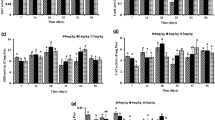Abstract
The acute toxicity and genotoxicity of carbendazim, two impurities (3-amino-2-hydroxyphenazine and 2,3-diaminophenazine) and one metabolite (2-aminobenzimidazole) to Eisenia foetida were assessed using artificial soil test and comet assay respectively. Acute toxicity results showed carbendazim was moderately toxic to the earthworms with 14 day-LC50 of 8.6 mg/kg dry soil while 3-amino-2-hydroxyphenazine, 2,3-diaminophenazine, and 2-aminobenzimidazole were of low toxicity with 14 day-LC50 values of 19.0, 14.9, and 27.7 mg/kg dry soil respectively (nominal concentration). The olive tail moment and percentage of DNA in the tail were used as genotoxicity indices, and carbendazim could significantly induce DNA damage to the earthworm coelomocytes with obviously positive dose- and duration-response relationships while the other three substances showed similar (p = 0.05) genotoxicity results to the negative controls in all of the tests.




Similar content being viewed by others

References
Anderson SL, Wild GC (1994) Linking genotoxic responses and reproductive success in ecotoxicology. Environ Health Perspect 102:9–12
Dikic D, Mojsovic-Cuic A, Cupor I, Benkovic V, Horvat-Knezevic A, Lisicic D, Orsolic N (2012) Carbendazim combined with imazalil or cypermethrin potentiate DNA damage in hepatocytes of mice. Hum Exp Toxicol 31:492–505
Document SANCO/12571/2013 (2013) Guidance document on analytical quality control and validation procedures for pesticide residues analysis in food and feed. http://www.eurl-pesticides.eu/library/docs/allcrl/AqcGuidance_Sanco_2013_12571.pdf. Accessed 2013
Dusre L, Covey JM, Collins C, Sinha BK (1989) DNA damage, cytotoxicity and free radical formation by mitomycin C in human cells. Chem Biol Interact 71:63–78
EFSA (2010) Conclusion on the peer review of the pesticide risk assessment of the active substance carbendazim. EFSA J 8:1598
Eyambe GS, Goven AJ, Fitzpatrick LC, Venables BJ, Cooper EL (1991) A non-invasive technique for sequential collection of earthworm (Lumbricus terrestris) leukocytes during subchronic immunotoxicity studies. Lab Anim 25:61–67
Food Safety News (2012) FDA detects carbendazim in 11 orange juice shipments. http://www.foodsafetynews.com/2012/01/. Accessed 28 Jan 2012
Greenpeace (2012) Pesticides: hidden ingredients in Chinese tea. http://www.greenpeace.org/. Accessed 11 Apr 2012
Grisolia CK (2002) A comparison between mouse and fish micronucleus test using cyclophosphamide, mitomycin C and various pesticides. Mutat Res Genet Toxicol Environ Mutagen 518:145–150
Konca K, Lankoff A, Banasik A, Lisowska H, Kuszewski T, Gozdz S, Koza Z, Wojcik A (2003) A cross-platform public domain PC image-analysis program for the comet assay. Mutat Res Genet Toxicol Environ Mutagen 534:15–20
Lebailly P, Vigreux C, Godard T, Sichel F, Bar E, LeTalaer JY, Henry-Amar M, Gauduchon P (1997) Assessment of DNA damage induced in vitro by etoposide and two fungicides (carbendazim and chlorothalonil) in human lymphocytes with the comet assay. Mutat Res Fundam Mol Mech Mutagen 375:205–217
Liu W, Zhu LS, Wang J, Wang JH, Xie H, Song Y (2009) Assessment of the genotoxicity of endosulfan in earthworm and white clover plants using the comet assay. Arch Environ Contam Toxicol 56:742–746
Liu XS, Zheng L, Huang WW, Lu W, Ning EC, Fang XM (2013) Simultaneous determination of thiophanate-methyl, 2-aminobenzimidazole, carbendazim, triabendazole and 5-hydroxy-triabendazole in concentrated fruit juices by LC-MS/MS. J Instrum Anal 32(1):84–88
OECD (1984) Guidelines for testing of chemicals. No. 207
Palanikumar L, Kumaraguru AK, Ramakritinan CM, Anand M (2014) Toxicity, biochemical and clastogenic response of chlorpyrifos and carbendazim in milkfish Chanos chanos. Int J Environ Sci Technol 11:765–774
Singh NP, McCoy MT, Tice RR, Schneider EL (1988) A simple technique for quantitation of low levels of DNA damage in individual cells. Exp Cell Res 175:184–191
Singh P, Srivastava AK, Singh AK (2008) Cell cycle stage specific application of cypermethrin and carbendazim to assess the genotoxicity in somatic cells of Hordeum vulgare L. Bull Environ Contam Toxicol 81:258–261
Song Y, Zhu LS, Wang J, Wang JH, Liu W, Xie H (2009) DNA damage and effects on antioxidative enzymes in earthworm (Eisenia foetida) induced by atrazine. Soil Biol Biochem 41:905–909
Song YC, Yu GC, Wang XF (2010) Research progress on reproductive toxicity of carbendazim. China Occup Med 37:505–507
Van Hummelen P, Elhajouji A, Kirsch-Volders M (1995) Clastogenic and aneugenic effects of three benzimidazole derivatives in the in vitro micronucleus test using human lymphocytes. Mutagenesis 10:23–29
Vigreux C, Poul JM, Deslandes E, Lebailly P, Godard T, Sichel F, Henry-Amar M, Gauduchon P (1998) DNA damaging effects of pesticides measured by the single cell gel electrophoresis assay (comet assay) and the chromosomal aberration test, in CHOK1 cells. Mutat Res Genet Toxicol Environ Mutagen 419:79–90
Wu PW, Kong MH, Ma YJ (2010a) Analysis of vegetables pesticides residue monitoring data during 2006–2009 in Shanxi province. Pestic Sci Adm 31:19–21
Wu PW, Hou RL, Ma YJ (2010b) Analyzing the reasons and the strategies for pesticides residue exceeding standard in celery. Pestic Sci Adm 31:35–37
Xing J, Yang WH, Ma YG, Li XJ, Yu L (2014) Determination method of 2-hydroxy-3-aminophenazine (HAP) and 2,3-diaminophenazine (DAP) in carbendazim, benomyl and thiophanate-methyl technical by HPLC. Agrochemicals 53(10):732–735
Acknowledgments
This research was supported by the Natural Science Foundation of Hainan Province, China (No. 413130) and the Fundamental Scientific Research Funds for Chinese Academy of Tropical Agricultural Sciences (Project No. 1630012013022).
Author information
Authors and Affiliations
Corresponding author
Rights and permissions
About this article
Cite this article
Huan, Z., Luo, J., Xu, Z. et al. Acute Toxicity and Genotoxicity of Carbendazim, Main Impurities and Metabolite to Earthworms (Eisenia foetida). Bull Environ Contam Toxicol 96, 62–69 (2016). https://doi.org/10.1007/s00128-015-1653-y
Received:
Accepted:
Published:
Issue Date:
DOI: https://doi.org/10.1007/s00128-015-1653-y



